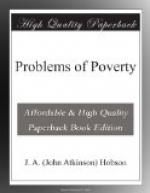“It may not be too much to say that if the whole of class B were swept out of existence, all the work they do could be done, together with their own work, by the men, women, and children of classes C and D; that all they earn and spend might be earned, and could very easily be spent, by the classes above them; that these classes, and especially class C, would be immensely better off, while no class, nor any industry, would suffer in the least.” Class C consists of 75,000, or 8 per cent., subsisting on intermittent earnings of from 18s. to 21s. for a moderate-sized family. Low-skilled labourers, poorer artizans, street-sellers, small shopkeepers, largely constitute this class, the curse of whose life is not so much low wages as irregularity of employment, and the moral and physical degradation caused thereby. Above these, forming the top stratum of “poor,” comes a large class, numbering 129,000, or 141/2 per cent., dependent upon small regular earnings of from 18s. to 21s., including many dock-and water-side labourers, factory and warehouse hands, car-men, messengers, porters, &c. “What they have comes in regularly, and except in times of sickness in the family, actual want rarely presses, unless the wife drinks.”
“As a general rule these men have a hard struggle, but they are, as a body, decent, steady men, paying their way and bringing up their children respectably” (p. 50).
Mr Booth, in confining the title “poor” to this 35 per cent. of the population of East London, takes, perhaps for sufficient reasons, a somewhat narrow interpretation of the term. For in the same district no less than 377,000, or over 42 per cent. of the inhabitants, live upon earnings varying from 21s. to 30s. per week. So long as the father is in regular work, and his family is not too large, a fair amount of material comfort may doubtless be secured by those who approach the maximum. But such an income leaves little margin for saving, and innumerable forms of mishaps will bring such families down beneath the line of poverty. Though the East End contains more poverty than some other parts of London the difference is less than commonly supposed. Mr Booth estimated that of the total population of the metropolis 30.7 per cent. were living in poverty. The figure for York is placed by Mr Seebohm Rowntree[4] at the slightly lower figure of 27.84. These figures (in both cases exclusive of the population of the workhouses and other public or private institutions) may be taken as fairly representative of life in English industrial cities. A recent investigation of an ordinary agricultural village in Bedfordshire[5] discloses a larger amount of poverty—no less than 34.3 per cent. of the population falling below the income necessary for physical efficiency.




